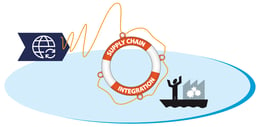How Can Advanced Planning and Scheduling Help the Automotive Industry?
Jesse Kelber - August 20, 2019

The automotive industry is no stranger to technology. It’s also no stranger to the rapid pace of change that’s overtaken global manufacturing in the early 21st-century. And when it comes to planning and organizing your entire automotive supply chain, advanced planning and scheduling (APS) is the key that will unlock increased ROI and decreased lag times. APS represents a sea change from traditional methods that looked at materials and production capacity as separate things, a view that often led to incompatible plans. Adoption rates of APS in the automotive sector are on the rise, paralleling the rise of make-to-order and additive manufacturing; and the increasing complexity of the automotive manufacturing world as a whole. And it’s that last factor that we’re going to focus on today, the increasing complexity of the automotive world and how APS can help. Whether by assisting with inventory leveling or by helping planners better schedule materials deliveries, APS can be a boon at every stage of the automotive manufacturing supply chain.
APS Picks up where ERP Leaves Off
Since ERP evolved from accounting software, it has a strong focus on what was and what is.
APS, on the other hand, was developed specifically to look at what comes next and how to minimize impact and streamline the processes involved. In other words, it works out the “what will be.” Advanced planning and scheduling refers to both a software solution and a management methodology that seeks to level raw materials with production capacity to better meet the fluctuating demand common in the automotive industry. Meanwhile, the graphic user interface on APS solutions gives you a real-time model of your production facility so you get a clear picture of materials usage and supply levels. This allows for more timely ordering and better balancing of remaining supplies, all of which is then picked up by the ERP when factoring in current operating costs. APS gives a finer-grained view of operations—down to a single process step—while ERP is concerned with the entire production line and how it interacts with the rest of the organization. And when it comes to the future of the automotive industry and the on-demand production in its near future, having both views covered is going to be crucial.
Shorter Delivery Times Facilitate a Faster Supply Chain
Perhaps one of the biggest, most noticeable ways advanced planning and scheduling can aid your value chain is by shortening delivery times. Advanced analytics built into the software allows for the most accurate demand forecasting ever, which in turn leads to better real-time controls on stock levels, and better use of existing logistics resources in delivering that stock to the customer the instant the order is complete. For example: if your factory produces a spring that goes into the transmission of several models, APS advanced analytics gives you a better idea of not only demand for that transmission but also the availability of the alloy that you use in the production of the spring. This way, you can time your supply orders, production runs, and delivery of an order of springs to the car plant with much tighter tolerances and shortened turn-around times.
With the growing use of on-demand additive manufacturing techniques and customization of cars at the factory, this is a key to staying competitive. If you can get your order out the door in less time than the competition, you’ll have the edge when your customers need supplies ASAP. Add to this the already complex nature of the automotive supply chain, and you begin to see another use for this technology—APS gives you a more granular view of your supply chain, focusing on one specific part or process rather than the often overwhelming overview provided by your ERP solution. That means you can plan around delivery delays of one individual part that goes into one specific vehicle just as readily as more generic materials. After all, keeping each line moving is key to keeping everyone’s bottom line down and ROI up.
The same advanced analytics help harmonize supply orders with upcoming demand, allowing for drastic cuts in necessary stock on hand. Which, in turn, means dramatic cuts to warehouse costs like electricity, security, climate control, and so on. With APS you can know precisely what is needed, and when, adjusting production to match that need. Now, when an order is complete it can be shipped out immediately, thus eliminating the need for partial orders taking up valuable warehouse space and resources while you wait for the next run to complete the order. And at the other end of the value chain, when a factory knows exactly what supplies are needed for the next production run and planners know they can receive those supplies nearly on-demand, they are similarly able to eliminate overages because they receive only the supplies they need for that run.
As Industry Becomes Data-Driven, the Automotive Sector Needs to Adapt to Keep Up
At this point, you know that data is critical for a business to stay on top of their game. And being able to use that data in real-time to make crucial business decisions is key to making that possible. The same intuitive GUI already mentioned allows you to put your company’s data to work for you. For example: say you encounter a shortage of a particular supply and need to sort out how to prioritize upcoming orders based on supplies on hand. APS helps by sifting the available data on your customers, outstanding orders, supply levels, and more. It then returns a list of possibilities for production order, letting you decide if the high-profile company needs to come before or after the lower-profile, but more fragile, local client.
As mentioned above, the automotive industry is known for many things, chief among them the speed of change. That means any solution implemented needs to be scalable and adaptable as well. APS tools put a drag-and-drop interface on top of a highly scalable database that’s as responsive as you need for real-time updates. This allows for easy updates to delivery schedules, production delays, etc. Need to shift a production run from facility 1 to facility 3? No problem: the operations team in each factory will be updated automatically, and the supplies en route will be rerouted appropriately. With these shifts comes an increasing reliance on data. Keeping that data current and accessible to everyone who needs it is one of the strong suits of APS software. Why? Because it acts as a centralized repository for schedules, delay information, and other documentation.
As if all that wasn’t enough, APS is ready for the coming demands of production as the focus of the auto industry shifts from internal combustion to electric motors, not to mention the increasing use of silicon-based computers being used. This shift in production from industrial areas to high tech centers overseas means that global weather patterns and other disruptions will rise as well. APS thrives in this cross-industry world by providing you the ability to visualize how the sectors and parts interact with each other, and how conditions in a Taiwanese chip plant can be causing delays in delivery of your finished car to showrooms in Canada.
If you want to learn more get your Guide to Industry 4.0:
LATEST POSTS
- Understand Circular Economy in The Manufacturing Industry
- How Can Industry 4.0 IT Integration Be Achieved Smoothly?
- The Significance of Order Sequencing in Discrete Manufacturing
- How to improve your Supply Chain Management: The Power of Control Towers
- Optimizing Human Resource Scheduling in Manufacturing: A Technological Approach



